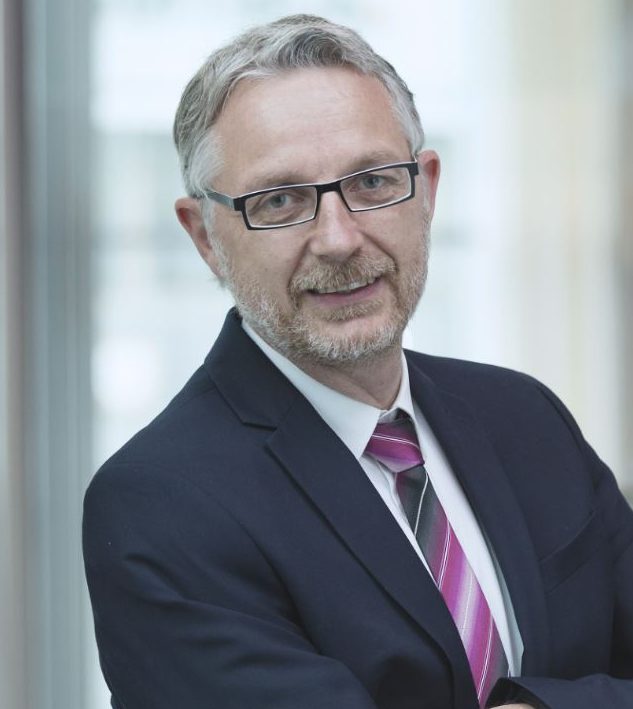An interview with Professor Dr. Peter Philippi-Beck (Steinbeis Transfer Center for Internationalisation – Equity Participation – Succession Regulation) and Hans-Joachim Hölz (Steinbeis Transfer Center for the Ravensburg District/WiR GmbH Ravensburg District/Steinbeis Transfer GmbH – Ravensburg- Weingarten University of Applied Sciences.)
What impacts do technological developments have on the success of a company and its future standing? To answer these questions, expert knowledge is required across a variety of specialist fields. To learn more about the best way to deal with these issues in business practice and examine the role networks play, TRANSFER magazine spoke to Professor Dr. Peter Philippi-Beck and Hans-Joachim Hölz.
Hello, Professor Philippi-Beck. You’re the founder of a Steinbeis Competence Team for Technology Implementation and Business Optimization (C|T|B). This is a regional networking hub that helps its customers to spot technology trends, and it provides support in translating these trends into new business models, future products, and production processes. What was your motivation for setting up the team?
My work as a Steinbeis consultant regularly involved issues revolving around technology change and the impact this has on the future of a company. The projects mostly had to do with manufacturing design – in fact they still do – or how to translate technologies into products, or how to adapt the competitive standing of a company. The way I see it, these are all key success factors for the future of a company – especially in a region that’s so heavily shaped by technology. The problems companies face involve so many aspects; this takes an expert understanding on an interdisciplinary level, and it was this that motivated me to set up the team of specialists. The Steinbeis competence team is called C|T|B and it looks at technology implementation and business optimization, pulling together specialists in product development, manufacturing design, and business development.
The partners of the C|T|B are the WiR in Ravensburg, the Fraunhofer Institute for Technology Trend Analysis INT, and Ravensburg- Weingarten University of Applied Sciences. What are the goals of this alliance?
Forming collaborative networks is seen as the most promising answer to technology convergence and the processes it’s associated with. These networks work on an interdisciplinary level and again, their point of reference is application-centric technology transfer between research and development and how this is implemented within companies. Because of this, it’s important not just to have expertise that spans different sectors of industry; the knowledge people draw on needs a broad foundation and the business focus has to be on the future. This is why we’re so pleased to have Fraunhofer INT on board as a network partner. It’s in an ideal position to draw on research into technology trends and make predictions about long-term technology developments. The institution responsible for economic development and the promotion of innovation in the region sees itself as a linchpin and a facilitator working between network partners and different companies. Ravensburg-Weingarten University of Applied Sciences is also a project partner and this adds expertise in the field of research, particularly in development.
Turning to you, Mr. Hölz, the WiR in Ravensburg does a lot to promote SMEs in the region, providing support with innovation programs in keeping with market needs. It does this by lining up contacts with specialists, collaboration partners, transfer partners, universities, and research establishments. What are the challenges of setting up and managing such a network of experts?
One of the fundamental issues facing lots of companies at the moment is how sustainable their current business model is. Given megatrends such as e-vehicles, 3D printing, and Industry 4.0 – to name but a few – in some instances the entire business models of companies are under threat. Companies in areas such as mechanical engineering have to consider carefully whether the products they’ve been manufacturing along conventional lines until now could be replaced by printed parts in their current form, especially in the future. Solutions are needed, matched specifically to the individual company. But as I just said, this is increasingly only possible with an interdisciplinary approach and often this also has to work across a number of companies. One of the difficulties is to establish a basis of trust between the different companies; this makes it possible to tackle the increasingly complex technological issues together and do this without the fear of losing know-how. On the one hand, this entails strong requirements regarding the ability of the parties who are managing innovation and networks to act as facilitators. On the other, it also requires professional consultation from experts. The expertise this requires is supplied by our network partner, the Steinbeis competence team for technology implementation and business optimization (C|T|B).
It’s particularly important for SMEs to recognize technology trends early, in fact it’s crucial for their survival, but they often don’t have the right resources. Is this where networks can lend a helping hand?
Philippi-Beck: Absolutely. Especially for smaller companies – digital transformation often fails because they don’t have the resources. If a company only has 20 employees, it often finds it really difficult to pull together the resources to manage such a complex issue. But despite this, smaller companies still have to cope with changes in technology structures, just like the big companies. With a functioning network, it’s easier to compensate for bottlenecks by transferring know-how and resources between the different network partners.
One of the key success factors associated with networks is trust. Is it easier or more difficult to engender trust and keep this sense of trust going in a region like Upper Swabia, especially given the influence of small and medium-sized enterprises?
Hölz: Geographical proximity and having so many companies that are owner-managed makes it easier to establish a sense of trust. We believe that the variety of the companies in Upper Swabia and the nature of the SME infrastructure have a decisive role to play in allowing these networks to function. The planning and setting up of the network with the WiR in Ravensburg, Steinbeis C|T|B, the university, and Fraunhofer is a good example of how well these structures function – the technology transfer process and the topics this transfer is based on undergo continuous improvement thanks to the feedback provided by the companies.
Contact

Professor Dr. Peter Philippi-Beck
Professor Dr. Peter Philippi-Beck is director of the Steinbeis Transfer Center for Internationalisation – Equity Participation – Succession Regulation. The Steinbeis Enterprise offers its customers consulting and support with management succession, mergers and acquisitions, the planning of funding concepts, and the development of business models against the backdrop of technological trends. The center is part of Steinbeis C|T|B.
Professor Dr. Peter Philippi-Beck
Steinbeis Transfer Center Internationalisation – Equity Participation – Succession Regulation (I/B/N) (Ravensburg)

Hans-Joachim Hölz
Hans-Joachim Holz is director of the Ravensburg District Steinbeis Transfer Center, managing director of WiR GmbH Landkreis Ravensburg, and managing director of Steinbeis Transfer GmbH at Ravensburg- Weingarten University of Applied Sciences. His work mainly revolves around providing support to companies with the implementation of innovation projects and helping them to leverage knowledge and technology transfer between science and academia on the one hand, and trade and industry on the other.
Hans-Joachim Hölz
Steinbeis Transfer Center Ravensburg District (Ravensburg)

